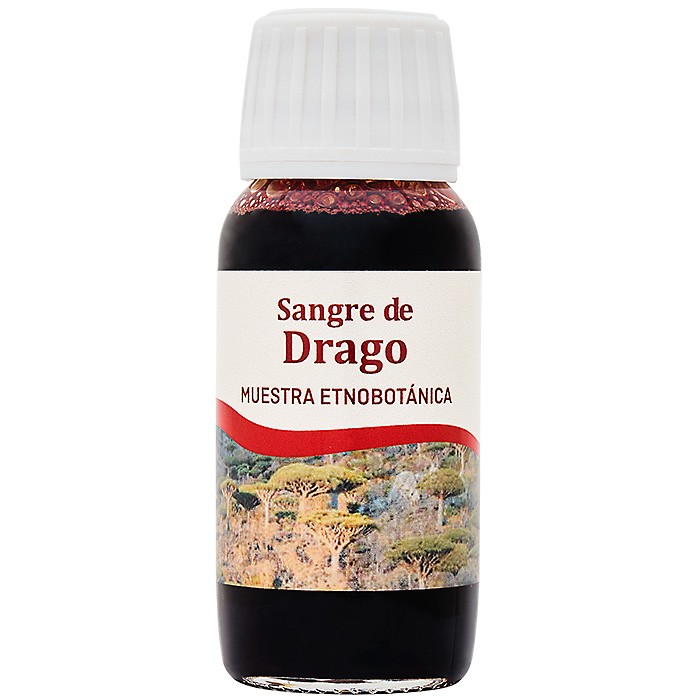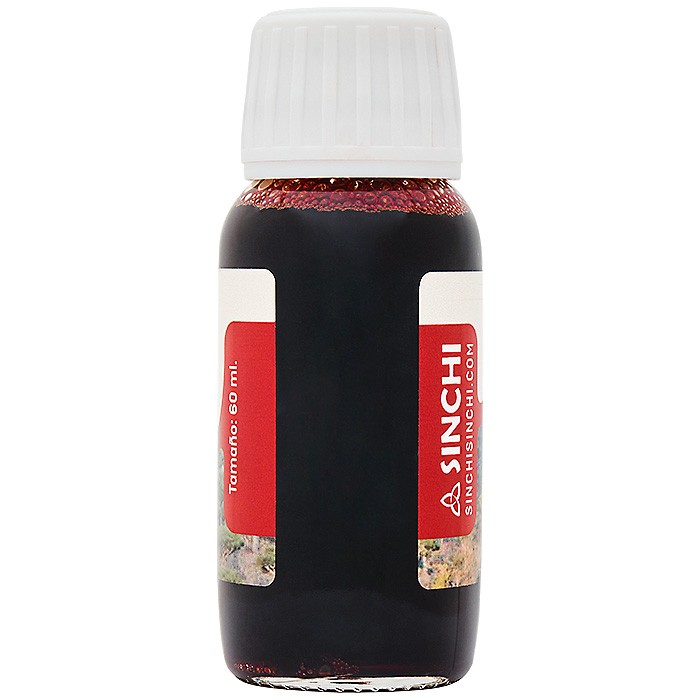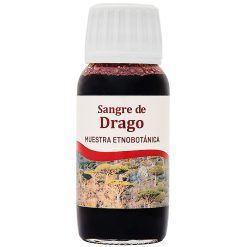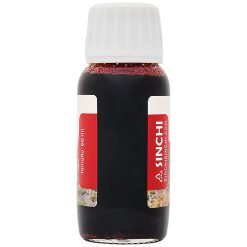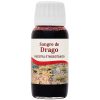Dragon’s Blood
32,00€
Drago’s Blood extracted from Croton Lechleri from the Amazon. Drago’s Blood is a thick liquid, very dark reddish in color, with properties that have given it an aura of mystery and great admiration since ancient times.
Native Americans use it as a medicinal remedy for a multitude of conditions, especially applied to the skin. Historically, many authors have referred to this liquid, always relating it to the dragon’s blood.
This name is used in traditional medicine on almost all continents, always referring to a viscous and reddish liquid.
Since the first century, the use of Drago’s Blood has been reflected in Greek mythology; The dragon’s blood gave rise, when it fell to the earth, to the trees from which the resin is extracted.
In Central and South America: In the 17th century, the Spanish naturist and explorer P. Bernabé Cobo described its healing properties. The traditional use of Sangre de Drago dates back centuries; In the year 1600, it was already used in Mexico, Peru and Ecuador.
Size: 60ml bottles
Esoteric use
In addition to therapeutic interest, magical properties are attributed to it and it was widely used in the composition of potions and elixirs.
Species
When talking about Sangre de Drago, reference is generally made to the species Croton Lechleri Müll Arg., the one in most widespread use, although since ancient times the same name has been used to refer to other species with similar properties of the genera Daemonorops, Dracaena and Pterocarpus, mainly:
Asia and Socotra: Daemonorops draco (Willd.) Blume of the Arecaceae family.
Canary Islands, Madeira, Morocco and China: Genus Dracaena, from the Asparagaceae family.
South America: Genus Pterocarpus, family Fabaceae.
Traditional use
Drago’s Blood contains the alkaloid taspine.
Dragon blood has been used for centuries by the indigenous tribes of the Amazon as a natural medicine.
One of the most common applications of dragon’s blood is its use as a healing agent to treat wounds, burns and ulcers. It is applied topically to affected skin to aid in tissue regeneration and prevent infections. It has also been used to treat skin conditions such as acne, dermatitis and psoriasis.
Another medicinal use of dragon’s blood is as a natural anti-inflammatory. It has been used to relieve pain and inflammation.
Its antimicrobial properties can help fight bacteria, viruses and fungi.
Anti-inflammatory: Dragon’s blood contains anti-inflammatory compounds that can help reduce inflammation and pain.
Antiviral: Dragon’s blood can be effective against some viruses.
Healing: Dragon’s blood has healing properties and is used to treat wounds, burns and skin ulcers. When the resin is applied to the skin, a protective layer is formed that helps prevent infection and promotes skin healing. The active ingredients that participate in this process are taspine and polyphenols (catechin and proanthocyanin).
Lignan (3′-4-O-dimethylcedrusin) also intervenes in healing and polyphenols by scavenging free radicals that stimulate wound contraction. The antibacterial action of polyphenols contributes to the healing process.
Antioxidant: Dragon’s blood contains antioxidants that help protect cells from damage caused by free radicals.
Pain reliever: Dragon’s blood has analgesic properties that can help relieve pain.
Improves oral health: Dragon’s blood is used in traditional medicine to treat dental problems such as gingivitis, periodontitis and halitosis. It is applied directly to the teeth and gums to relieve pain and reduce inflammation.
Treatment of skin diseases: Dragon’s blood is used to treat a variety of skin diseases, including eczema, psoriasis and herpes. It is applied directly to the affected skin to reduce inflammation and speed healing.
Antimicrobial activity due to the presence of polyphenols, polyacetylenes, flavonols, terpenoids, steroids, alkaloids, propolis, chlorechinic acid, coberins A and B and 1,3,5-trimethoxybenzene.
The antibacterial activity is due to phenolic compounds, flavonoids, anthocyanins.
It contains proanthocyanins, the component that gives it its red color.
History
Greek mythology
The Drago tree takes its name from the dragon that guarded the golden apples in the Garden of the Hesperides, property of the goddess Hera, wife of Zeus.
Some place the Garden of the Hespérides in the Fortunate Islands, the name by which the Canary Islands have been known since Antiquity. In this magical garden there was an apple tree, which Gaia had given to Hera at her wedding to Zeus, whose golden fruits granted immortality to those who ate them. They were guarded by a hundred-headed dragon that never slept, called Ladon.
Heracles, in his eleventh labor, which consisted of stealing the apples of the Hesperides, ended the dragon’s life with a well-aimed arrow and from each drop of blood that flowed from Ladon’s wounds, dragons or trees called dragon trees were born.
These dragon-trees were called Dragos; in honor of the dragon. Its thick trunk, from which a cluster of twisted branches emerges, is also reminiscent of the hundred heads of Ladón, while the red resin that comes off its trunk is known as dragon’s blood.
Heracles was the only one who managed to steal the apples. Some time later the goddess Athena returned them to the Garden of the Hesperides.
Roman mythology
Pliny the Elder
According to Pliny, dragon’s blood was blood spilled by the legendary basilisk that lost its life in a deadly fight with an elephant. In his natural history he calls dragon’s blood sanguis draconis, and tells about it: “it is the blood of a dragon crushed by the weight of a dying elephant, mixed with the blood of both animals.”
“imals.”
Possibly, the event comes from Indian mythology, where the fierce fight between Brahma, the creator, and Shiva, the destroyer, who take the form of an elephant and a cobra, is narrated; This is also hinted at by Pliny, who refers to India as the origin of this substance.
Canary Islands
Dragon blood was part of the ointments used by the Guanches (ancient aborigines of the island of Tenerife, in the Canary Islands, who inhabited it before the Castilian conquest in 1496) in the mummification process, although no archaeological evidence has been found. to confirm it.
In the 15th century, dragon blood was already marketed in Europe. In the mid-14th century, when the first modern contacts were established between European navigators and Canarian aborigines, the price of dragon’s blood was on the rise and its trade was very profitable, as was that of slaves, seashells, skins. curtidas and orchilla, a lichen used as a dye that is very abundant on the coastal cliffs of the Canary Islands.
The process to extract the sap must have influenced the decay of these trees, since it was obtained by making cuts that were too deep in the trunk, which made them vulnerable to bacteria, fungi and insect larvae. By the end of the 16th century, most of the dragon trees had been bled and only a few specimens survived, many of them on inaccessible cliffs.
South America
Cristobal Monardes
Greek and Roman authors often spoke of “dragon’s blood” to refer to a very valuable red substance, but they did not specify what they were referring to by that name.
Merchants continued to sell it, although without knowing whether the “dragon’s blood” that classical authors spoke of had animal, vegetable or mineral origin. It could even be a mixed substance, as Pliny the Elder had described.
Between 1565 and 1574, Cristóbal Monardes, a doctor from Seville, published his Medicinal History of the Things That Are Brought from Our West Indies in three parts. In the second part he refers to the dragon tree (1574 Edition). It begins with the title, “The Dragon” and a drawing of the fruit of the tree, whole and in cross section, showing a small dragon inside.
The passage is the following:
After having written what was said above, the two fleets arrived, one from Tierra Firme and the other from New Spain. And in Tierra Firme came the bishop of Cartagena, a very religious and learned man and very curious about these things, who looked for me immediately upon arriving, because he was fond of the book we made on this herbal material.
I went to visit him, and talking about many things about herbs and plants that are in his diocese, we came to discuss dragon blood, which is produced very finely and in complete perfection in that land, and he told me: “I bring the fruit of the tree from which they get dragon blood, which is a wonderful thing to see, because it is like an animal. I wanted to see it and we opened a leaf of this seed, and, opening the leaf, a dragon appeared made with so much artifice that it seemed alive: the neck was long, the mouth was open, the hill was bristling with thorns, the tail was long and on his feet; that, true, there is no one who sees it who is not amazed to see his figure, made with so much artifice that it seems to be made of ivory, that there is no craftsman so perfect that he could do it better.
Seeing that I saw it, I was reminded of as many opinions and as many different views as the ancients had about this, both Greeks, Latins and Arabs, saying a thousand nonsense to try to teach us why it was called dragon’s blood: some saying that it was He says because, /92 after cutting the throat of a dragon, that blood is taken and made with certain things, and for this reason they call it dragon’s blood; Others say it is the blood of a drowned elephant, with other things; others, that it is a type of vermilion; others, that it is syderitis juice, a very small grass and its juice very green; others, that it is the juice of a root of an herb called draconium, and that is why they call it dragon’s blood. This is what the ancients say and many more nonsense that will take a long time to write.
The moderns, following this same ignorance, as they usually do in things that are doubtful, because their job is not to say anything new, except in what is clear and manifest, that in what is doubtful and difficult they leave it as they find it. .
They all rave, as the ancients did. But time, which is the discoverer of all things, has discovered and taught us what dragon’s blood is and why it is said like this: and it is because of the fruit of this tree and that it sheds this tear, like blood, which is the fruit we said. Which is a dragon, formed as nature wanted to produce it, from which the tree very clearly took its name.
Because it is a common thing for trees to have a name for their fruits, for which this wonderful tree received its name, and it took away from us, by seeing the fruit it bears, made a dragon, of so many doubts and so much confusion.
It is how we see the ancients and the moderns writing.
And from now on we will be certified that dragon blood is and why it is called dragon blood, since its fruit gives the name to the tree and to the gum and tears that come from it, which they bring most excellent from Cartagena, which is made by incision stabbing the same tree, which, despite being a very large tree, has a very thin bark, which can split open with anything.
Likewise, it is made not as good as turpentine is made in Castile, which is sold in loaves. One is called gota dragon’s blood, and the other is called dragon’s blood in bread.
Both have the virtue of retaining any flow of the stomach, placed in the belly or placed in clysters and taken by mouth. Powdered and poured into the head, it prohibits movement from the head to the lower parts. Applied to any blood flow, it retains and stagnates it.
Comfrey and conglutinates fresh and recent sores. It prevents teeth from falling out and makes flesh grow on corroded gums. It is a wonderful color for painters. And without these it has many other virtues. I plan to sow the seed to see if it will be born in these parts. Dragon’s blood is considered to be tempered with little heat.
Today we know that neither the Cartagena de Indias tree nor any other known tree have seeds or fruits with a wonderful dragon shape, so Monardes’s certainty is disconcerting.
The name always given to the resin or tear extracted from the tree “sangre de drago” (not “dragon’s blood”) naturally brought to mind the Canary Islands tree (Dracaena draco), whose name “drago” has been attested since the century XV.
In the text, reference is made to Cartagena [de Indias], and the two fleets mentioned are the groups of merchant ships escorted by warships that made regular round-trip routes between Spain and America, to protect merchant ships. from attacks by pirates and privateers.
Monardes does not give the name of the bishop of Cartagena who came in the Tierra Firme fleet, but indicates that this arrival occurred when he had already written the above. Since his book was published in 1572, the prelate must be the fifth in that diocese, Dr. Juan de Simancas, from Córdoba and a schoolboy from Bologna, who after having held office there for ten years, fell ill and returned to Spain, where he died in 1570.
From the story it is deduced that the tree they spoke of was not the canary, but another from South America, which was planted in the bishop’s diocese.
Juan Simancas wrote that there was, indeed, a resin called Cartagena dragon tree blood, which was extracted from Pterocarpus officinalis Jacq., Pterocarpus draco L.
In the Monardes news, however, all the emphasis is on the wonderful shape of the seeds. Intrigued by what the prelate told him, he asked to see them and was amazed to find there a little dragon formed with so much art that it looked like an ivory figurine.
His description and the drawing that accompanies it clearly show that he uses the word “dragon” not in the sense of large snake, which it had in classical texts, but in the sense that was already common in his time to name the fabulous animal with Reptile body and legs.
Having contemplated the dragon-shaped seed, it was natural for Monardes that the blood-colored resin that emerged, when an incision was made in the bark of the tree, was called “dragon blood.”
///
In 1572, Philip’s doctor and surgeon, Juan Fragoso, published in Madrid a work that dealt with a topic similar to the one Monardes had just addressed: The Discourse on Aromatic Things.
These past years they sent from the Canary Islands to Her Majesty some trees, in my opinion somewhat similar to palms, which they called dragon trees, and, placed in their gardens, they perished, even though they were given as gifts. They gathered together the fruit, which is like a silique or skin, in which the seed is enclosed. Which opened, then appears a dragon with a long neck, an open mouth, a bristling hill and a long tail. This is evidence of the ignorance of the ancients and many moderns, who never guessed or managed to know what dragon’s blood was and why it was called, neither knowing the plant nor the etymology of the name.
Later, here it is known to grow these trees on dry land, from where the gum commonly called teardrop dragon’s blood emerges by incision, which some believe to be the true cinnabar of Antiquity.
Another sophisticated and artificial dragon’s blood is commonly sold, which is made from Brazil and resin or with a mixture of some gum, which is distinguished from the real one in that the false one dissolves in wine or liquor, which does not happen to the good.
Regarding the figure of the dragon inside the seed, Fragoso exposes the same as Monardes. Although Fragoso does not mention Monardes, he seems to have him in mind and even want to correct him.
The tree whose fruit contains the figure of a small dragon, the tree from which the “dragon’s blood” is obtained, had already been known in Madrid for years, because some specimens had been sent from the Canary Islands to the royal gardens.
In 1601, the Latin translation of Fragoso’s book was published in Strasbourg by Israel Spach, a physician, doctor from the University of Tübingen and professor in Strasbourg, where he was from. He himself points out in the preface that he had limited himself to revising and organizing the unpublished version of another: «Louis Demoulins de Rochefort, French nobleman of Blois, favorite doctor of Margaret of Valois, sister of Francis I, king of France, and advisor of Manuel Filiberto de Saboya.
It is clear, then, that the work of Philip II’s Spanish doctor immediately interested his French colleague, who undertook the translation into Latin very shortly after its publication. Demoulins de Rochefort lived between 1515 and 1582.
The Margaret of Valois mentioned is the famous author of the Heptameron, better known as Margaret of Navarre or Margaret of Angoulême.
The Manuel Filiberto of Savoy mentioned in the work was governor of the Netherlands and commanded the army of the king of Spain in the battle of San Quentin.

